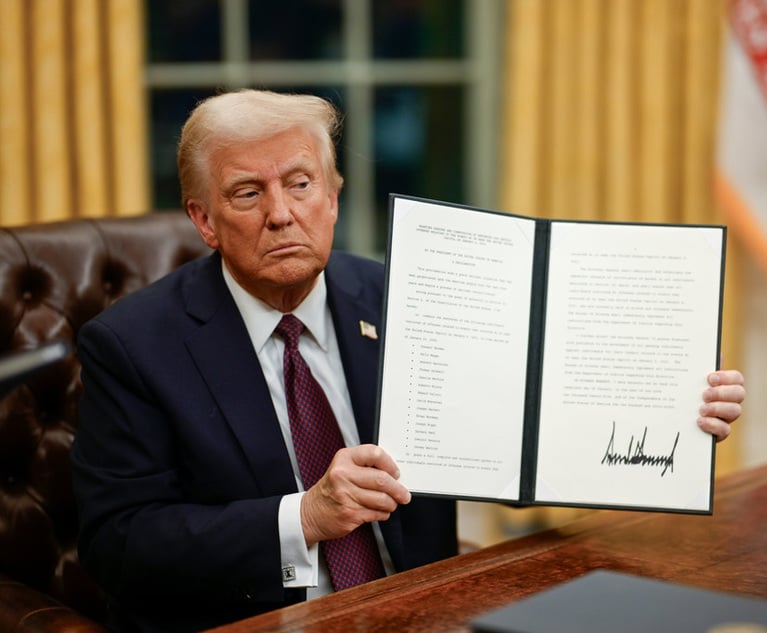The Latest Fashion in Fashion Patents
What do fashion designers and famous clothing brands such as Jimmy Choo®, Christian Dior®, Louis Vuitton® and Crocs® have in common?
September 05, 2018 at 02:30 PM
7 minute read
Fashion designers face multiple challenges, not the least of which are rapidly changing styles and the outright theft of design ideas. Many fashion houses, particularly startups, choose to protect their brands through the robust use of trademarks. If appropriate, such protective strategies can and should be complemented by the strategic use of patents. In light of two recent changes in the patent ecosystem, the case of patent protection has become even more compelling.
Background
What do fashion designers and famous clothing brands such as Jimmy Choo®, Christian Dior®, Louis Vuitton® and Crocs® have in common? In addition to having valuable trademarks to protect their brand, they also defend their signature, innovative clothing and accessories with patents.
Patents are as old as the nation itself. The U. S. Constitution authorizes Congress “To promote the Progress of Science and useful Arts, by securing for limited Times to authors and Inventors the exclusive right to their respective writings and discoveries.” This clause in Section 8 of Article 1 created the Patent Office and the Copyright Office of the Library of Congress. Unfortunately, the protection afforded by copyright law in the United States is generally not available for fashion and clothing designers. Under many circumstances, however, patent law can provide designers with protection that is not available through copyright.
The U.S. Patent and Trademark Office (USPTO) issues two types of patents for clothing and accessories: design patents and utility patents. Design patents protect how something appears, including its shape, configuration or surface ornamentation. In many countries, this type of intellectual property is referred to as an industrial design registration. Utility patents protect the way an article is used and works; it includes processes and methods. Both design and utility patents may be obtained on the same article. Utility patents far outnumber design patents. Every year, the USPTO receives approximately 35,000 design patent applications compared to over a half million utility patent applications. There are approximately 826,000 issued design patents and over 10 million issued utility patents.
Design Patents: The Rocket Docket Blasts Off
A design patent lasts 15 years after it is issued, and it takes an average of 19 months for an application to go through the examination process. For an additional fee, the USPTO offers an expedited examination called the Rocket Docket, which can result in an issued patent in less than six months, cutting the usual wait time by over a year. While the program has been around for a few years, the latest revisions to procedures make the application process easier. Note, too, that when an item is introduced in the marketplace before a patent application is filed, the designer has one year to file a patent before losing rights. This is a much more lenient process than that of many countries, which require patent applications to be filed before any disclosure.
Even with expedited examinations, however, there is still a significant lag time. Design patents typically cover items that last more than one season, such as footwear, handbags and eyewear, as well as packaging for cosmetics and fragrances. Additionally, design patents are often used for design elements that can be translated to multiple garments, such as distinctive top stitching, stud patterns and pocket styles.
The U.S. recently became signers of the Hague Agreement Concerning the International Registration of Industrial Designs. The Hague Agreement is an international registration system that offers the possibility of obtaining protection by filing a single international application in a single language. This can be done either directly with the World Intellectual Property Organization (WIPO) or indirectly through the USPTO. While patents are territorial, the Hague Agreement enables the application process throughout the participating countries with a single set of documents. The applicant selects the appropriate countries and regions where the product will be manufactured, distributed or sold; each jurisdiction applies its own law and rules to the application, resulting in multiple registrations.
Utility Patents
The second type of patent available is a utility patent, which is the most familiar type of patent. Utility patents are useful for functional garments, such as maternity garments, undergarments that shape and uplift body parts, and infant clothing, as well as footwear and eyewear. Related areas for patenting are high-performance fabrics, such as deodorizing fabrics, waterproof and flame-resistant fabrics. Functional athletic attire, such as golf gloves and cleated shoes, is also protected by utility patents. The integration of technology into clothing, such as electronic sensors in shoes and heart rate monitors in shirts, is another area showing increased numbers of utility patents.
The USPTO is a participant in the Patent Cooperation Treaty and the Paris Treaty, both of which permit U.S. utility patent applicants to use their U.S. patent application as a basis for applications throughout the world.
Compared to design patents, utility patents are significantly harder to obtain, take longer to proceed through the examination process (on average 24 months) and last longer. Utility patents last 20 years after the date of filing; they require periodic payments to the USPTO in order to maintain the patents in force. Generally, the application for a utility patent has about a 10% chance of being initially accepted; most applications are rejected at least once. This rigorous process is considered to produce a higher quality, valid patent. About 75% of the applications overcome the first rejection and continue on to become patents. Accordingly, the application for a utility patent inevitably requires additional work by the patent attorney; the cost of overcoming the rejection must always be included in the prospective patent holder's budget.
Design vs. Utility Patents
Savvy companies file many applications to protect their valuable intellectual property. For example, in one week in August 2018, NIKE® was granted 17 patents: six utility and 11 designs. Not surprisingly. many of these were for athletic shoes, but some were for athletic wear. One of the utility patents, Knitted Component with Adjustable Knitted Portion, protects a new weave for stretchable fabrics. Valentino s.p.A. received a design patent for men's dress shoes, showing that designs are applicable to all types of shoes, not only athletic footwear.
Louis Vuitton Malletier and Christian Dior Couture both received design patents recently. The Christian Dior Couture patent is for sunglasses and the Louis Vuitton Malletier patent is for a distinctive package.
Both Hanes and Under Armour received utility patents for brassieres. These six examples were selected at random from a single issue of The Official Gazette for Patents, where the USPTO lists all the patents issued for that one week, and show the range of patents in the fashion industry.
Upon closer examination, Louis Vuitton's design patent for a package is an example of how patents can strengthen branding. While trade dress, such as packaging, is protected in the United States by trademark law, it must be in use for at least five years and achieve secondary meaning, such that consumers can recognize the source of goods. A design patent can become available to a brand in less than two years. SPANX® has design patents for how their products are displayed at retail and they include a utility patent and a design patent.
Conclusion
Which type of patent is better for the clothing designer? As noted, the utility patent lasts longer, generally providing around 17 to 18 years of effective protection versus 15 years for a design patent. The utility patent costs more to obtain, takes longer to issue and requires periodic payments. Each type of patent protects different aspects of an article, so the answer lies in what is novel about the garment: its appearance or how it is used.
When filing any type of patent, a designer must take into consideration not only the novelty of the garment but also how patent protection fits into his or her overall business and branding strategies. Ultimately, these activities should be fully integrated into business operations and the patent process.
Patricia Werschulz is an intellectual property lawyer and a registered patent attorney at Werschulz Patent Law. Sandra Holtzman is chief marketing strategist at Marketing Cures, a marketing, communications, public relations, digital and market research company.
This content has been archived. It is available through our partners, LexisNexis® and Bloomberg Law.
To view this content, please continue to their sites.
Not a Lexis Subscriber?
Subscribe Now
Not a Bloomberg Law Subscriber?
Subscribe Now
NOT FOR REPRINT
© 2025 ALM Global, LLC, All Rights Reserved. Request academic re-use from www.copyright.com. All other uses, submit a request to [email protected]. For more information visit Asset & Logo Licensing.
You Might Like
View All
How Some Elite Law Firms Are Growing Equity Partner Ranks Faster Than Others
4 minute read

Trending Stories
- 1Legal Restrictions Governing Artificial Intelligence in the Workplace
- 2Failure to Adequately Inform Patients
- 3'FTX' One Year Later: The Impact on Examiner Practice in Bankruptcy Courts
- 4Gen AI Legal Contract Startup Ivo Announces $16 Million Series A Funding Round
- 5DOJ's Flawed Thinking in Challenging HPE-Juniper Merger
Who Got The Work
J. Brugh Lower of Gibbons has entered an appearance for industrial equipment supplier Devco Corporation in a pending trademark infringement lawsuit. The suit, accusing the defendant of selling knock-off Graco products, was filed Dec. 18 in New Jersey District Court by Rivkin Radler on behalf of Graco Inc. and Graco Minnesota. The case, assigned to U.S. District Judge Zahid N. Quraishi, is 3:24-cv-11294, Graco Inc. et al v. Devco Corporation.
Who Got The Work
Rebecca Maller-Stein and Kent A. Yalowitz of Arnold & Porter Kaye Scholer have entered their appearances for Hanaco Venture Capital and its executives, Lior Prosor and David Frankel, in a pending securities lawsuit. The action, filed on Dec. 24 in New York Southern District Court by Zell, Aron & Co. on behalf of Goldeneye Advisors, accuses the defendants of negligently and fraudulently managing the plaintiff's $1 million investment. The case, assigned to U.S. District Judge Vernon S. Broderick, is 1:24-cv-09918, Goldeneye Advisors, LLC v. Hanaco Venture Capital, Ltd. et al.
Who Got The Work
Attorneys from A&O Shearman has stepped in as defense counsel for Toronto-Dominion Bank and other defendants in a pending securities class action. The suit, filed Dec. 11 in New York Southern District Court by Bleichmar Fonti & Auld, accuses the defendants of concealing the bank's 'pervasive' deficiencies in regards to its compliance with the Bank Secrecy Act and the quality of its anti-money laundering controls. The case, assigned to U.S. District Judge Arun Subramanian, is 1:24-cv-09445, Gonzalez v. The Toronto-Dominion Bank et al.
Who Got The Work
Crown Castle International, a Pennsylvania company providing shared communications infrastructure, has turned to Luke D. Wolf of Gordon Rees Scully Mansukhani to fend off a pending breach-of-contract lawsuit. The court action, filed Nov. 25 in Michigan Eastern District Court by Hooper Hathaway PC on behalf of The Town Residences LLC, accuses Crown Castle of failing to transfer approximately $30,000 in utility payments from T-Mobile in breach of a roof-top lease and assignment agreement. The case, assigned to U.S. District Judge Susan K. Declercq, is 2:24-cv-13131, The Town Residences LLC v. T-Mobile US, Inc. et al.
Who Got The Work
Wilfred P. Coronato and Daniel M. Schwartz of McCarter & English have stepped in as defense counsel to Electrolux Home Products Inc. in a pending product liability lawsuit. The court action, filed Nov. 26 in New York Eastern District Court by Poulos Lopiccolo PC and Nagel Rice LLP on behalf of David Stern, alleges that the defendant's refrigerators’ drawers and shelving repeatedly break and fall apart within months after purchase. The case, assigned to U.S. District Judge Joan M. Azrack, is 2:24-cv-08204, Stern v. Electrolux Home Products, Inc.
Featured Firms
Law Offices of Gary Martin Hays & Associates, P.C.
(470) 294-1674
Law Offices of Mark E. Salomone
(857) 444-6468
Smith & Hassler
(713) 739-1250







